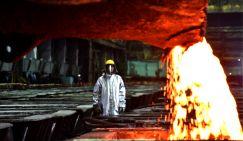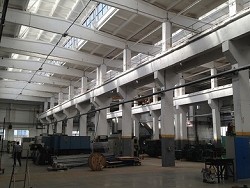If the Soviet Union was a leader in powder metallurgy, modern Russia is in the backyard

Alexander Sitnikov

Metallurgical plant in Norilsk (Photo: Denis Kozhevnikov/TASS)
At the end of August a number of Russian publications perepechatala “Better and cheaper: Urfu strikes at foreign powders”. In a nutshell: in Novouralsk run designed at the Ural Federal University, an industrial unit for manufacture of powder for additive machines. Its capacity is 20 tons per year.
Taking off his hat to the developers, at the same time as it is impossible to divide jingoistic enthusiasm for “blow”. Perhaps it would be better to say that the domestic industry powder technology finally wakes up after at least three decades of hibernation and makes the first steps.
On the situation in the industry is described in detail in the marketing research Agency MegaResearch for 2015, saying that “the Russian serial production of powders is minimal and carried out mainly in the laboratory. The only production of the domestic product is ЭП648 — powder heat-resistant alloy based on Nickel is used for additive manufacturing of heat-resistant products in power engineering and the aerospace industry.”
Meanwhile, the technologies of powder production, inextricably linked with 3D printing, explosively spread all over the world. The list of countries that lead in this industrial revolution speaks for itself: USA (company ExOne, 3D Systems, POM, Optomec, Sciaky and FDM), Germany (SLM Solutions, EOS, Concept Laser, Fraunhofer IFAM) and France (Phenix Systems).
We’re definitely lagging behind. It is not even to keep pace with the times, though, logically, it is in our country powder industry should grow at a faster rate. Additive machines are in demand, especially in small-scale high-tech manufacturing, particularly in the defense industry, aviation industry and space industry. That is where there is an urgent need for parts with complex geometry, for which traditional methods often required a Park bench. In addition, 3D printing is ideal for prototyping, and therefore, accelerates the development of new machines and products.
Although in the West the undisputed pioneer in this field called 3D Systems, which in 1986 presented the first stereolithographically machine — SLA — Stereolithography Apparatus in the USSR in the 70-ies actively used injection molding machines TP-63 injection molding with injection. And in 1980, was patented method of hot isostatic pressing of large-sized products from metal powder — certificate SU 1470455 A1. It is, in fact, talking about the prototypes of modern additive machines. In other words, Soviet scientists on an equal footing to compete with Western professionals.
Then in the 90’s and “zero” the path of additive methods to factories for Americans and Europeans was thorny, and for the Russians — a dead end. Difficulties with the spurting of boiling metal and microporousity in the process of layer-by-layer sintering were such that it was easier to give up. But the most devastating factor for our nascent industry of 3D printing was the industrial policy of the authorities, since the reign of Gorbachev. In Russia the technocrats on a gun shot did not podpisalis to the control lever. As a result, money for these purposes did not allocate.
By and large, only in 2010 in our country was marked by the interest in additive manufacturing, is associated primarily with the success of the Corporation “Boeing”, which to their aircraft began to “print” tens of thousands of parts of different kinds.
The fact that at the end of the last century were scientific exotic, suddenly began to make a profit. For comparison, in the Russian aircraft production rate “buy-to-fly” (how many of the purchased materials fly — ed.) is evaluated on the difficult parts in the ratio of 20:1, and the Americans — 2:1.
It is logical that in America one summer day in 2012 I suddenly realized that 3D printing is strategically important. It was then Barack Obama in Langston opened the first of 15 national innovation institutions additive orientation — National Additive Manufacturing Innovation Institute. The Ministry of Commerce of the United States were instructed to “strengthen competitiveness” in this area. Moreover, ordered the money to spare, and the budget was immediately allocated $ 1 billion.
At the opening ceremony of the Institute in Langstone the US President stressed: “the future welfare and security of America starts here and now.” For professionals, it became clear that the developed additive machines, like a drop of water, reflects the innovative capacity of economies in the competing States. For the development of this industry must possess advanced technologies in the field of layer-by-layer synthesis and powder materials, in the manufacture of lasers and optics in the measurement, instrumentation and fine mechanics, vacuum technology and control systems. And this is not a complete list of required knowledge.
If to speak about Russia, we cannot say that in this area nothing was done, although the situation is reminiscent of the old joke — “we slowly go down from the mountain…”. At the same time our manufacturers have already “tasted” 3D printing. In particular, OAO “NIAT NTK” learned “to print the” nozzles of aircraft engines and turbine blades, and OAO “AB Universal” — the details of the fuel supply. The situation changed dramatically only after the introduction of us sanctions, when it became clear that count on Western additive machines and materials is not necessary.
Once, as they say, with nothing, the Council on modernization of economy of the Russian Federation in September 2014 gave specific instructions on development of printers, powders and feedstock (wire — ed.), the country’s Leadership has set the task at the expense of the national welfare Fund, and other sources, to urgently produce additive import substitution. Time flustered officials and managers of the Ministry of education, Ministry of economic development, Minpromtorg, the Ministry of communications, FANO, Russian Academy of Sciences, Federal space Agency, Rosatom, Rosstandart, Ministry of Finance, RVC, SKOLKOVO, RUSNANO, Vnesheconombank, export Agency EXIAR. One gets the impression that those “who manages and divides the money,” much more those “who designs and researches”.
Among the priority measures is a problem of urgent development of extremely complex devices — efficient laser head, set up by and could not a well-known Western companies. Ideal dreams for us, according to some sources, is the analogue of the South Korean car MX-3 with CO2-laser, five-axis control and multi-channel flow. Another problem is the quality control of powder, as today there are virtually no methods of standardization and evaluation of materials for additive technologies. And a tiny fraction of the country faced challenges, which have to spin the head of the Russian officials responsible for the case. After all, no wonder the Americans open 15 major specialized institutes, and money is not spared.
Of course, to solve additive import needs huge investments, which, apparently, the Federal budget is not provided. However, if the authorities dream about the domestic counterparts overseas technology, why not use the American experience of collecting money for this purpose through progressive taxation homegrown Nouveau riche. In the end, for our country is a matter of life and death.







